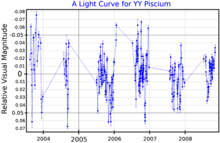30 Piscium
  | |
| Observation data Epoch J2000 Equinox J2000 | |
|---|---|
| Constellation | Pisces |
| Right ascension | 00h 01m 57.61947s[1] |
| Declination | −06° 00′ 50.6540″[1] |
| Apparent magnitude (V) | 4.31 – 4.41[2] |
| Characteristics | |
| Spectral type | M3 III[3] |
| B−V color index | 1.631±0.011[4] |
| Variable type | LPV,[5] LB?[2] |
| Astrometry | |
| Radial velocity (Rv) | −11.7±0.5[6] km/s |
| Proper motion (μ) | RA: 46.941 mas/yr[1] Dec.: −40.471 mas/yr[1] |
| Parallax (π) | 7.8758 ± 0.4105 mas[1] |
| Distance | 410 ± 20 ly (127 ± 7 pc) |
| Absolute magnitude (MV) | −1.20[5] |
| Details | |
| Radius | 109.2+5.46 −6.05[7] R☉ |
| Luminosity | 1,597±177[7] L☉ |
| Surface gravity (log g) | 2[8] cgs |
| Temperature | 3,490±35[7] K |
| Other designations | |
| Database references | |
| SIMBAD | data |
30 Piscium (HIP 154) is a solitary[10] variable star in the zodiac constellation of Pisces. It is visible to the naked eye with an apparent visual magnitude of 4.37.[8] Its calculated mid-value of antiposed parallax shift as the Earth moves around the Sun of very roughly 7.88 mas, makes it around 410 light years away.[1] Its net movement in the present epoch is one of moving closer – radial velocity (speed away from our star system) is −12 km/s.[6]

This is an aging red giant star with a stellar classification of M3 III,[3] indicating it has exhausted the hydrogen at its core and evolved off the main sequence. It is a candidate long-period variable star[5] and has been given the designation YY Psc.[12] It varies in brightness between magnitudes 4.31 and 4.41 with no clear period. Possible periods of 23.1, 32.0, 53.6, and 167.8 days have been identified.[11] The star has 109 times the Sun's radius and is radiating 1,600 times the luminosity of the Sun from its enlarged photosphere at an effective temperature of 3,490 K.[7]
References
- ^ a b c d e Vallenari, A.; et al. (Gaia collaboration) (2023). "Gaia Data Release 3. Summary of the content and survey properties". Astronomy and Astrophysics. 674: A1. arXiv:2208.00211. Bibcode:2023A&A...674A...1G. doi:10.1051/0004-6361/202243940. S2CID 244398875. Gaia DR3 record for this source at VizieR.
- ^ a b Samus, N. N.; Durlevich, O. V.; et al. (2009). "VizieR Online Data Catalog: General Catalogue of Variable Stars (Samus+ 2007-2013)". VizieR On-line Data Catalog: B/GCVS. Originally Published in: 2009yCat....102025S. 1. Bibcode:2009yCat....102025S.
- ^ a b Keenan, P.; McNeil, R. (October 1989), "The Perkins catalog of revised MK types for the cooler stars", Astrophysical Journal Supplement Series, 71: 245–266, Bibcode:1989ApJS...71..245K, doi:10.1086/191373.
- ^ Anderson, E.; Francis, Ch. (2012), "XHIP: An extended hipparcos compilation", Astronomy Letters, 38 (5): 331, arXiv:1108.4971, Bibcode:2012AstL...38..331A, doi:10.1134/S1063773712050015, S2CID 119257644.
- ^ a b c Rimoldini, L.; et al. (December 2012), "Automated classification of Hipparcos unsolved variables", Monthly Notices of the Royal Astronomical Society, 427 (4): 2917–2937, arXiv:1301.1545, Bibcode:2012MNRAS.427.2917R, doi:10.1111/j.1365-2966.2012.21752.x, S2CID 119191320.
- ^ a b de Bruijne, J. H. J.; Eilers, A.-C. (October 2012), "Radial velocities for the HIPPARCOS-Gaia Hundred-Thousand-Proper-Motion project", Astronomy & Astrophysics, 546: 14, arXiv:1208.3048, Bibcode:2012A&A...546A..61D, doi:10.1051/0004-6361/201219219, S2CID 59451347, A61.
- ^ a b c d Baines, Ellyn K.; Thomas Armstrong, J.; Clark, James H.; Gorney, Jim; Hutter, Donald J.; Jorgensen, Anders M.; Kyte, Casey; Mozurkewich, David; Nisley, Ishara; Sanborn, Jason; Schmitt, Henrique R.; Van Belle, Gerard T. (2021). "Angular Diameters and Fundamental Parameters of Forty-four Stars from the Navy Precision Optical Interferometer". The Astronomical Journal. 162 (5): 198. arXiv:2211.09030. Bibcode:2021AJ....162..198B. doi:10.3847/1538-3881/ac2431.
- ^ a b Pérez Martínez, M. I.; et al. (November 2014), "The non-active stellar chromosphere: Ca II basal flux", Monthly Notices of the Royal Astronomical Society, 445 (1): 270–279, Bibcode:2014MNRAS.445..270P, doi:10.1093/mnras/stu1706.
- ^ "30 Psc". SIMBAD. Centre de données astronomiques de Strasbourg. Retrieved 2018-03-10.
- ^ Eggleton, P. P.; Tokovinin, A. A. (September 2008), "A catalogue of multiplicity among bright stellar systems", Monthly Notices of the Royal Astronomical Society, 389 (2): 869–879, arXiv:0806.2878, Bibcode:2008MNRAS.389..869E, doi:10.1111/j.1365-2966.2008.13596.x, S2CID 14878976.
- ^ a b Tabur, V; Bedding, T. R; Kiss, L. L; Moon, T. T; Szeidl, B; Kjeldsen, H (2009). "Long-term photometry and periods for 261 nearby pulsating M giants". Monthly Notices of the Royal Astronomical Society. 400 (4): 1945. arXiv:0908.3228. Bibcode:2009MNRAS.400.1945T. doi:10.1111/j.1365-2966.2009.15588.x. S2CID 15358380.
- ^ Kukarkin, B. V.; et al. (January 1975), "60th Name-List of Variable Stars", Information Bulletin on Variable Stars, 961: 1, Bibcode:1975IBVS..961....1K.
- v
- t
- e
| Bayer |
|
|---|---|
| Flamsteed |
|
| Variable | |
| HR | |
| HD | |
| Other |
| Exoplanets |
|---|
| Messier | |
|---|---|
| NGC |
|
| Other |
 Category
Category









